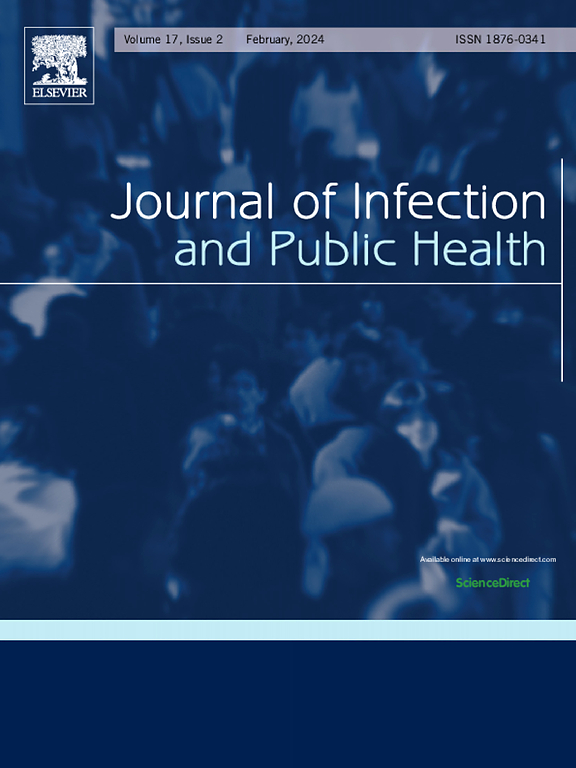Non-tuberculosis mycobacterial infection among clinically suspected tuberculosis in eastern India (2019–2023)
IF 4
3区 医学
Q1 INFECTIOUS DISEASES
引用次数: 0
Abstract
Background
Incidence of non-tuberculous mycobacterial (NTM) infections is on rise globally and poses significant diagnostic and treatment challenges for tuberculosis as most of them are resistant to anti-tubercular drugs. NTM susceptibility to drugs varies from species to species and there is no specific regimen for treatment. We conducted this study to understand the epidemiology of NTM infections in Odisha from 2019 to 2023.
Methods
All the samples referred from districts suspected for NTM infections were subjected to culture followed by species identification using line probe assay (Hain Lifesciences, details). Anti-mycobacterial susceptibility was determined by MIC breakpoints and the analysis was done as per the Clinical and laboratory Standard Institute (CLSI) M24S 2018 guidelines.
Results
A total of 828 suspected NTM infection samples were included in the study. Non- tuberculous mycobacteria were found in 67 (8.1 %, 67/828) samples. The most prevalent non-tuberculous mycobacteria isolated was found to be M. intracellulare (32.8 %,22/67), followed by M. abscessus (22.3 %, 15/67), M. fortuitum (11.9 %,8/67), and M. scrofulaceum (8.9 %),6/67). Non tuberculosis mycobacterial disease was seen from most of the districts but it was more common in the coastal districts of Odisha like Khordha (29.8 %,20/67), Cuttack (11.9 %,8/67), Bhadrak (8.9 %,67), Kendrapada (7.4 %,5/67), Balasore (4.4 %, 3/67), Jajpur (4.4 %, 3/67), Puri (7.4 %,5/67). NTM was more prevalent in males (65.7 %) than females (34.3 %). The MIC breakpoints showed different sensitive and resistant patterns for NTM isolates. It was seen that M. mucogeniucum was sensitive to all the drugs tested, M. avium and M. abscessus isolates were resistant to most of the drugs and sensitive to few drugs like doxycycline, kanamycin and clarithromycin.
Conclusion
The increasing prevalence of NTM infections necessitates precise identification at the species level, coupled with drug susceptibility testing (DST), to guide targeted therapy. This approach is critical not only for optimizing patient outcomes but also for mitigating the emergence of antimicrobial resistance through inappropriate or empirical treatment strategies.
2019-2023年印度东部临床疑似结核病患者非结核分枝杆菌感染情况分析
在全球范围内,非结核分枝杆菌(NTM)感染的发病率呈上升趋势,由于大多数结核分枝杆菌对抗结核药物具有耐药性,因此对结核病的诊断和治疗提出了重大挑战。NTM对药物的敏感性因物种而异,没有特定的治疗方案。我们进行这项研究是为了了解2019年至2023年奥里萨邦NTM感染的流行病学。方法对疑似NTM感染地区的所有样本进行培养,然后用线探针法进行物种鉴定(Hain Lifesciences,详细)。通过MIC断点确定抗分枝杆菌敏感性,并根据临床和实验室标准研究所(CLSI) M24S 2018指南进行分析。结果共纳入疑似NTM感染样本828份。非结核分枝杆菌67例(8.1 %,67/828)。非结核分枝杆菌以胞内分枝杆菌最多(32.8% %,22/67),其次为脓肿分枝杆菌(22.3% %,15/67)、福图分枝杆菌(11.9 %,8/67)和结核分枝杆菌(8.9 %,6/67)。非结核分枝杆菌病在大多数地区可见,但在奥里萨邦沿海地区更为常见,如霍达(29.8 %,20/67)、卡塔克(11.9 %,8/67)、巴德拉克(8.9 %,67)、肯德拉帕达(7.4 %,5/67)、巴拉索(4.4 %,3/67)、贾浦尔(4.4 %,3/67)、普里(7.4 %,5/67)。NTM男性患病率为65.7% %,女性患病率为34.3% %。NTM分离株的MIC断点表现出不同的敏感和耐药模式。结果显示,黏液分枝杆菌对所有药物均敏感,分离的鸟分枝杆菌和脓肿分枝杆菌对大部分药物耐药,对多西环素、卡那霉素和克拉霉素等少数药物敏感。结论NTM感染呈上升趋势,需要在物种水平上进行精确鉴定,并结合药敏试验(DST)指导靶向治疗。这种方法不仅对优化患者预后至关重要,而且对于通过不适当或经验性治疗策略减轻抗菌素耐药性的出现也至关重要。
本文章由计算机程序翻译,如有差异,请以英文原文为准。
求助全文
约1分钟内获得全文
求助全文
来源期刊

Journal of Infection and Public Health
PUBLIC, ENVIRONMENTAL & OCCUPATIONAL HEALTH -INFECTIOUS DISEASES
CiteScore
13.10
自引率
1.50%
发文量
203
审稿时长
96 days
期刊介绍:
The Journal of Infection and Public Health, first official journal of the Saudi Arabian Ministry of National Guard Health Affairs, King Saud Bin Abdulaziz University for Health Sciences and the Saudi Association for Public Health, aims to be the foremost scientific, peer-reviewed journal encompassing infection prevention and control, microbiology, infectious diseases, public health and the application of healthcare epidemiology to the evaluation of health outcomes. The point of view of the journal is that infection and public health are closely intertwined and that advances in one area will have positive consequences on the other.
The journal will be useful to all health professionals who are partners in the management of patients with communicable diseases, keeping them up to date. The journal is proud to have an international and diverse editorial board that will assist and facilitate the publication of articles that reflect a global view on infection control and public health, as well as emphasizing our focus on supporting the needs of public health practitioners.
It is our aim to improve healthcare by reducing risk of infection and related adverse outcomes by critical review, selection, and dissemination of new and relevant information in the field of infection control, public health and infectious diseases in all healthcare settings and the community.
 求助内容:
求助内容: 应助结果提醒方式:
应助结果提醒方式:


